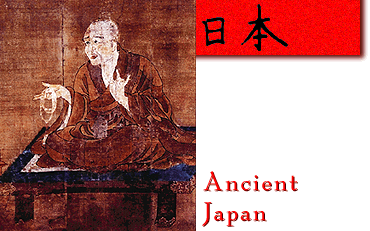

 |
appear in history until 57 AD when it is first mentioned in Chinese histories, where it is referred to as "Wa." The Chinese historians tell us of a land divided into a hundred or so separate tribal communities without writing or political cohesion. The Japanese do not start writing their histories until around 600 AD; this historical writing culminates in 700 AD in the massive chronicles, The Record of Ancient Matters and the Chronicles of Japan. These chronicles tell a much different and much more legendary history of Japan, deriving the people of Japan from the gods themselves. The Japanese are late-comers in Asian history. Preceding their unification and their concern with their own history in the latter half of the first millenium AD is a long period of migration and settlement. Where did the Japanese come from? Why did they settle the islands? What did life look like before history was written down? In order to get a handle on ancient Japanese history, it helps to consider that it is driven by outside influences. The first involved the settlement of Japan by a group of peoples from the Korean peninsula in the third century BC. Overnight they transformed the stone-age culture of Japan into an agricultural and metal-working culture. These early immigrants are ultimately the origin of Japanese language and culture. The second great push in Japanese history was contact with China from 200 AD onwards. From the Chinese, who demanded that Japan be a tribute state to China, the Japanese adopted forms of government, Buddhism, and writing. While Japanese culture ultimately derives from the immigrants of the third century BC, the bulk of Japanese culture is forged from Chinese materials—a fact that will drive an entire cultural revolution in the eighteenth and nineteenth centuries as scholars attempt to reclaim original Japanese culture from its Chinese accretions. |
 |
that suffuses every aspect of Japanese culture is its geography. Japan is a series of islands—the group consists of over 3000 islands of which 600 are inhabited. The four main islands, Honshu, Kyushu, Shikoku, and Hokkaido dominate Japanese history, however. The largest island is Honshu, but the overall geographical area of the inhabited islands is less than California. The climate is pleasantly moderate, for the islands lie in the path of the Black Current which flows north from the tropics. All the islands are mountainous and subject to a variety of natural disasters, especially earthquakes and tsunamis. The mountainous terrain leaves its mark on Japanese culture; since the mountains provide natural and difficult barriers, political life in Japan centered around regional rather than national governments. The earliest flowering of Japanese history took place in the low-lying plains on the island of Honshu, especially the Yamato plain in the south—a region that gave its name to the first "official" name for Japan, Yamato. There the very first Japanese kingdom arose and provided the basis of future Japanese civilizations. |
| Japan as a series of islands has always
been isolated from the mainland from about 10,000 B.C. to the present day. For this reason, the original
inhabitants managed to hold on to stone-age life long after the regions to
the west had urbanized. This island status has also protected Japan from
foreign invasions. Only twice in Japanese history has the island been
successfully overrun by foreigners: in the third century BC by the wave of
immigrations from the Korean peninsula, and in 1945 by the United States.
The areas of Japan which have shown the most cultural change are those, as you might imagine, that are closest to the mainland of Asia. The southern island of Kyushu and the southwestern peninsula of Honshu lie close to the Korean peninsula. It is in this region that the Japanese first immigrated into Japan in the third century BC, and it is in this region that the first state in Japan was established: the Yamato State on the Yamato peninsula (the southwesternmost peninsula on Honshu). Despite the late arrival of Japan into written history, the beginnings go back ten thousand years to a mysterious people which would eventually produce a unique and vital culture, the Jomon. |